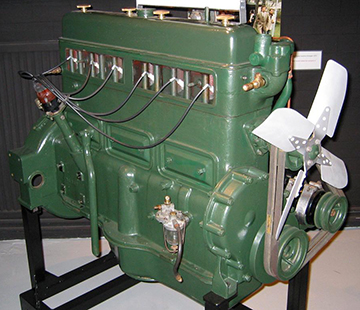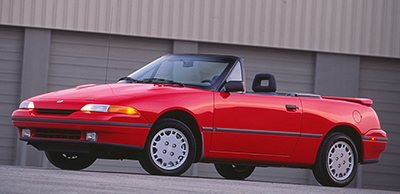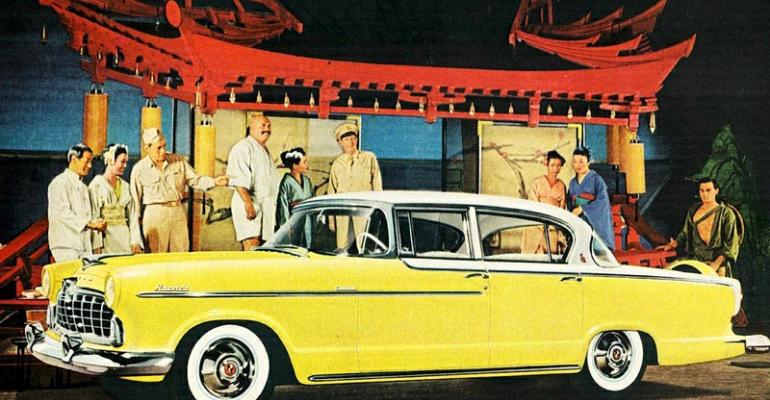75 Years Ago (February 1940): Record January Output;
More Military Business; Waukesha Oil Engine; Ford Tax decision

As Ward’s earlier forecast, car and truck production in the U.S. and Canada set a January record estimated at 465,000 units. That bested by 10.1% the prior benchmark of 422,538 set in January 1929 and topped like-1939’s 356,950 completions by 30%. Chevrolet led the industry with 114,000 units, followed by Ford-Mercury production at 110,000 and Plymouth running third at 56,600 vehicles. However, with dealer inventory rising, Ward’s forecasts February production will be trimmed to no more than 340,000 units, but allows that a faster than expected selling pace could boost production beyond that level. Still, even 340,000 units is a 7.1% gain from the 317,520 vehicles assembled a year ago.
Aside from increasing orders for cars and trucks, orders for other military equipment are “gradually creeping into the motor and supplying plants,” according to WAR. “A check of citizenship has already taken place in Packard, Cadillac, Plymouth, Dodge and other plants in Detroit where such business is under way.” Workers in other facilities also have been notified to produce evidence of citizenship, as required by the War Dept. Orders for such items as shell casings, steel stampings, marine engines and plane-engine parts are referred by the War Dept. as “educational” orders, because there is no official authorization to obtain them.

Waukesha Motor is continuing efforts to promote the use of the Hesselman low-compression oil-burning engine, built in a range from 40-300 hp. The blocks and most internal parts are nearly identical to those in a gasoline engine because the low compression does not require the heavier components necessary to withstand the stress developed by a diesel engine. Licensed under Hesselman’s Swedish patents, Waukesha builds a range of oil-burning engines for use in Ingersoll-Rand road-grading and construction equipment. Waukesha says it is building the engines in 10 displacements, many capable of readily being installed in trucks, tractors and buses. In addition to oil, the fuel-injected spark engines can run on gasoline and propane.
The auto industry is breathing a sigh of relief after a Denver district court rules Colorado’s chain-store tax is not applicable to Ford dealerships. The court said attributes of chain-store organization do not apply to auto dealerships as established by Ford. The industry feared dealers would face new levies in Colorado and other states with similar taxes.
70 Years Ago (February 1945): Car Inventory Dwindles;
Truck-Tire Expansion; More Trackless Trollies Seen

According to the War Production Board, 4,000 cars are being taken out of service daily due to lack of tires, replacement parts, accidents and scrappage. Despite that, the dwindling supply of new ’42 cars put in government inventory when civilian-car production ended in 1942 is so low that only 2,000 will be available for allocation in February. With all-out production of trucks and war-related materiel, no cars will be built again in 1945, the WPB says. That means, according to the Office of Defense Transportation (responsible for rationing new cars to essential workers) many people holding government certificates enabling them to purchase a new car will not be able to do so. ODT says its figures indicate the U.S. car population dwindled to 24,400,000 as of Jan. 1, 1945, down from 25,900,000 a year earlier. Furthermore, some 650,000 cars currently registered are sidelined by lack of tires and/or replacement parts. The agency says it will take three record-breaking post-war years of production to satisfy current pent-up demand for new cars, estimated at 12 million to 15 million units. What’s more, “no fully practicable substitute for private car transportation is possible in the American economy.”
Despite a $70 million government-financed expansion of truck-tire manufacturing operations now getting under way, tires for civilian use will be in short supply in 1945, due to a 30% increase in military requirements. This is likely to result in most available tires going to Priority A drivers at the expense of those classified “B” and “C.” As well, smaller-size truck tires will have to be constructed with cotton cord due to a shortage of rayon. Augmenting the dwindling supply of natural rubber, synthetic rubber production is expected to top 1.0 million long tons (2,240 lbs. or 1,016 kg) this year, but overall tire output will see only a small increase over 1944.

Electric trolley coaches, “so-called trackless trolleys,” are seen playing a more important role in post-war public transportation than traditional trollies. Following V-Day, electrical equipment manufacturers say, transit system modernization favors the use of the electric trolley because it creates a minimum of street congestion, reduces noise, provides a smoother ride than traditional trollies, and reduces fumes associated with buses. According to one study, operating costs for tractless trollies average 0.751 cents per seat mile compared with 0.841 cents for buses. In addition, a second study says during a recent cold wave, only two of 29 electric trolley coaches were sidelined by the weather, compared with 148 of 425 buses.
60 Years Ago (February 1955): Sharp A/C Rise Seen; Wagons Set Record;
Experimental Disc Brake; Corvette Changes Coming

Automakers are forecasting the installation of 120,000 air conditioners in ’55-model cars, more than double the 52,429 installed in ’54 and more than four times the 28,611 tallied in ’53. In addition, WAR projects the number of dealer-installed units will remain steady at 15,000 units, the same as in ’54, but 25% ahead of the 12,000 installed in ’53. Holding back even greater consumer acceptance, the publication says, is the relatively high price, averaging $580, and the need to combine the components into a single front-mounted unit rather than having components in the trunk. Among the brands offering the least costly A/C are Nash and Hudson. Both offer front-mounted units that combine heating, defrosting and cooling at prices of $345 and $395 for the two brands, respectively. In addition, Ford will soon begin installing its new single-lever Select Aire system in ’55 models. Priced at $425, plus installation, Ford’s dealer-installed system also combines heating, cooling, defrosting and ventilating capabilities. It will be offered on all standard V-8-powered Ford models, including station wagons.

Production of station wagons will reach a record 450,000 units in ’55, according to WAR, up from 350,500 in ’54. The ’55 tally will equal 29.2% of entire post-war wagon output of 1,540,600 units built in 1946-54. Among manufacturers, Ford accounted for 53.2% of all wagons built in ’54, up from 37.3% in ’53. GM’s share rose only slightly to 25.8% from 25.2%, while Chrysler’s share fell to 10.7% in ’54 from 26.7% in ’53. Independents American Motors and Studebaker accounted for the remaining 10.3% of ’54 wagon output compared with 10.8% in ’53.
Goodyear is assisting in the development of a new disc-brake system for cars developed by an independent engineer who recently migrated from Europe. The system has a good chance of revolutionizing present brake systems, according to the Goodyear engineers testing the design. “Playing a vital role in the success of the brake are little buttons the size of half-dollars that function like the linings of conventional brakes.” The test system functions in a manner similar to Goodyear’s aircraft disc brakes, but utilizes only a single disc on each wheel. According to the company, “cars traveling at 60 mph (97 km/h) have stopped in less than 120 ft. (37 m) with safety, even on wet highways, and without throwing passengers forward.”

Chevrolet is rushing changes to its much ballyhooed Corvette that will further enhance its appeal. Among the changes for ’55 are an optional V-8 engine and 3-speed manual transmission, along with a 12-volt electrical system for V-8 models. Engineers also are looking at replacing the removable plastic side curtains with roll-up windows, but that may require significant alteration to the doors and likely will not appear in this year.
50 Years Ago (February 1965): Record Production Seen;
Chevy Unveils Sportvan; Plymouth Concept Bows; Dealer Profit Slips
Based on automakers’ internal production schedules, Ward’s says U.S. car production is slated to reach 930,000 for the first time ever in March. If achieved that would surpass the any-month record 866,007 cars built in December 1964 by 7.4%. In addition, the publication forecasts output of 8.3 million cars in U.S. plants in the ’65 model run, a 5% increase from the record 7,892,000 built in ’64. Although ’65 model year production through January lagged the prior year by 68,000 units, it is seen surpassing ’64 by nearly 400,000 cars by May-June.

Chevrolet takes the wraps off its new compact Sportvan passenger van. It replaces the Corvair Greenbrier, production of which ended in December. Sportvan has a layout similar to that of the Ford Club Wagon with forward-control seating and a water-cooled I-6 engine housed between the front seats, unlike the Greenbrier that was powered by a rear-mounted air-cooled H-6. It rides on a 90-in. (2,286-mm) wheelbase, carries up to eight passengers with optional seating, or up to 2,000 lbs. (907 kg) of cargo. It is available in three trim levels with a base sticker price starting at $2,355 excluding freight charges and federal excise tax. Dual swing-out doors are standard on the passenger side and at the rear of the van. The side doors feature a foldout step.

Plymouth has unveiled its new VIP concept car at the Chicago Auto Show. It features light-sensitive glass that adjusts to light intensity, iridescent exterior paint that changes color depending on the angle from which it is viewed and a camera in place of the traditional rearview mirror. Unique instruments include gauges that show the rate of fuel flow and the estimated time of arrival at a preset destination. Other convenience features include a telephone, refreshment center, Dictaphone, TV and a stereophonic audio system.
U.S. franchised dealer pre-tax profits dropped to 1.8% of total sales in record-year 1964, from 1.9% in 1963, according to the National Automobile Dealers Assn. Still, it was ahead of the 1.7% profit ratio seen in the prior record year 1955. Also, the share of dealers operating the red in 1964 dropped to 5.8% from 6.3% the prior year. UAW strikes at Ford and GM that resulted in a “serious” shortage of cars in the fourth quarter were blamed in large part for the decline in dealer profits. NADA says one encouraging trend in 1964 was a rise in the average selling price of used cars to $849 from $821 in 1963 and $779 in 1962.
25 Years Ago (February 1990): Camshafts to Fade;
Capri, Miata Differ; JJ Plant Named; Cadillac Wants Aurora
In an interview, the president and CEO of Siemens Automotive tells WAR advances in engine valve-actuator technology will make it possible to eliminate the camshaft by the year 2000. The executive says his company will have electronically controlled engine valve actuators in production by the mid-1990s. Such a system allows infinitely variable intake and exhaust valve timing, lift and phasing to maximize performance and fuel economy. Siemens says it has experimented with an EVA system in a 1.9L Ford engine where it was able to reduce idle speed to as low as 200 rpms with a concurrent lowering of emissions.

Speaking at the Chicago Auto Show, Ford Motor officials say the new Mazda-based Mercury Capri sporty car being imported from Australia will appeal to an entirely different range of buyers than Mazda’s new Miata sports car. Ford says Capri’s front-wheel-drive layout, small rear set, optional automatic transmission and lower prices will make it attractive to younger buyers, particularly women. The automaker says research shows the typical Capri buyer will be a 27-year-old professional earning about $36,000 annually. About 60% are expected to be women. In contrast, the Miata buyer typically will be 43-year-old male professional with an annual income of $80,000, the company notes. First-year Capri sales are pegged at 8,000-10,000 units, or about 25% of forecast Mazda Miata volume.
A Chrysler-Renault joint venture has chosen a plant in Valladolid, Spain, as one of two manufacturing sites for the upcoming new JJ “baby” Jeep. A North American site is expected to be announced within six weeks, and production at both facilities is slated to begin by mid-1992. The new model is to be powered by Chrysler’s 2.2L I-4 mounted longitudinally, mated to a Chrysler transaxle and single-speed transfer case. About the size of a Suzuki Sidekick/Geo Tracker, the JJ will have front and rear independent suspension. The vehicle is to be sold in Europe by Chrysler and Renault, but Chrysler will handle all North American marketing. Output in Europe is forecast at 70,000 units, with a like volume built in North America.

Reports from Cadillac indicate the division’s executive would like to introduce a production version of the Aurora concept car as quickly as possible to attract younger buyers. However, Cadillac has yet to submit the program for corporate approval. If it did go into production, the Aurora would not feature a cathode-ray-tube display, because, according to a GM official, “you can’t have a premium American motor car with a high-tech screen in it. It is inconsistent.” Thus the CRT is dead at Cadillac and Buick, although Oldsmobile has embraced it to enhance Olds’ high-tech image.





